SWEDISH SOUTH ASIAN STUDIES NETWORK
SASNET collection of Nordic University Dissertations on South Asia
Kept at SASNET’s root node office library, Scheelevägen 15 D, Lund, first floor, room 2040
A
• Ahmed, Ishtiaq (1986). The Concept of an Islamic State. An Analysis of the Ideological Controversy in Pakistan. Dept. of Political Science, Stockholm University. St. Martin’s Press, New York. ![]()
• Ahmed, Syed Masud (2005). Exploring health-seeking behaviour of disadvantaged populations in rural Bangladesh. Division of Geriatric Epidemiology; Department of Neurobiology, Caring Sciences and Society (NVS); Karolinska Institutet Medical University, Stockholm
• Alam, Mohammed Nurul (2002). Financing of small and cottage industries in Bangladesh by Islamic banks: an institutional-network approach. Lund studies in economics and management, 72. Lund: Lund Business Press.
• Aldén, Ann (2003). Religion in dialogue with late modern society: a constructive contribution to a Christian spirituality informed by Buddhist-Christian encounters. Lund: Centre for Theology and Religious Studies, Lund University.
• Alm, Björn (2006). The un/selfish leader: changing notions in a Tamil Nadu village. Stockholm: Department of Social Anthropology, Stockholm University.
• Amundsen, Ingun Bruskeland (2003). On sacred architecture and the dzongs of Bhutan: tradition and transition in the architectural history of the Himalayas. (Oslo): Arkitekthøgskolen i Oslo.
• Aneer, Gudmar (1973). Akbar the Great Mogul and his religious thoughts. Skrivservice, Uppsala
• Arora-Jonsson, Seema (2005). Unsettling the order: gendered subjects and grassroots activism in two forest communities. Acta Universitatis agriculturae Sueciae, 2005:70. Uppsala: Dept. of Rural Development and Agroecology, Swedish University of Agricultural Sciences.
• Arvidson, Malin (2003). Demanding values: participation, empowerment, and NGOs in Bangladesh. Lund dissertations in sociology, 51. Lund: Dept. of Sociology, Lund Univ.
• Axenov, Serge (2007). The Balochi Language of Turkmenistan: A corpus-based grammatical description. Uppsala: Acta Universitatis Upsaliensis.
 • Aziz Hasan, Mh. (2008). Arsenic in alluvial aquifers in the Meghna basin, South-Eastern Bangladesh: Hydrogeological and geochemical characterisation. KTH Architecture and the Built Environment, Royal Institute of Technology (KTH), Stockholm
• Aziz Hasan, Mh. (2008). Arsenic in alluvial aquifers in the Meghna basin, South-Eastern Bangladesh: Hydrogeological and geochemical characterisation. KTH Architecture and the Built Environment, Royal Institute of Technology (KTH), Stockholm
B
• Bali Swain, Ranjula (2001). Demand, segmentation and rationing in the rural credit markets of Puri. Economic studies (Uppsala), 54. Uppsala: Dept. of Economics (Nationalekonomiska institutionen)
• Banik, Dan (2002). Democracy, drought and starvation in India: testing Sen in theory and practice. Series of dissertations submitted to the Department of Political Science, Faculty of Social Sciences, University of Oslo, 2003, no. 35. Oslo: Dept. of Political Science, University of Oslo.
• Bergenhorn, Mats (2006). Öppna universum!: slutna traditioner i Salman Rushdies Satansverserna. Lund studies in history of religions, 22. Stockholm: Almqvist & Wiksell International.
• Berglie, Per-Arne (1983). Gudarna stiger ned: Rituell besatthet hos sherpas och tibetaner. Stockholm dissertations in comparative religion, 2. Stockholm: (s.n.).
• Berglund, Henrik (2000). Hindu nationalism and democracy: a study of the political theory and practice of the Bharatiya Janata Party. Stockholm studies in politics, 73. Stockholm: Univ.
• Bergquist, Daniel Alcala (2008). Colonized Coasts. Aquaculture and Energy flows in the World System: Cases from Sri Lanka and the Philippines. Dept. of Social and Economic Geography, Uppsala University
• Blomqvist, Gunilla (2004). Gender discourses at work: export industry workers and construction workers in Chennai, Tamil Nadu, India. Göteborg: Dept. of Peace and Development Research, Göteborg University.
• Broo, Måns (2003). As good as God: the guru in Gaudiya Vaisnavism. Åbo: Åbo Akademi University Press.
• Brun, Cathrine (2003). Finding a place: local integration and protracted displacement in Sri Lanka. Dr. Polit. thesis, Norwegian University of Science and Technology NTNU Trondheim, 2003.
• Burman, Johan (2006). Stable oxygen and carbon isotopes in recent and subfossil Littorinidae shells: a high resolution method for paleoenvironmental reconstructions. Earth Sciences Centre, Göteborg University, 105. Göteborg: Göteborg University.
C
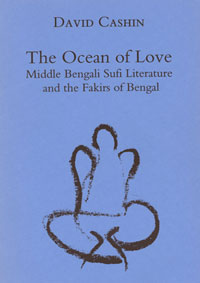 • Cashin, David (1995). The Ocean of Love. Middle Bengali Sufi Literature and the Fakirs of Bengal. Association of Oriental Studies, Stockholm University
• Cashin, David (1995). The Ocean of Love. Middle Bengali Sufi Literature and the Fakirs of Bengal. Association of Oriental Studies, Stockholm University
• Cavallin, Clemens (2002). The efficacy of sacrifice: correspondences in the Rigvedic Brahmanas. Göteborg: Dept. of Religious Studies (Institutionen för religionsvetenskap), Univ.
• Cederlöf, Gunnel (1997). Bonds lost: subordination, conflict and mobilisation in rural south India c. 1900-1970. New Delhi: Manohar.
• Chakrabarty, Antarin (2008). Communicative Planning and Democratic Decentralisation in India - Case of Kolkata City. Trondheim: Dept. of Urban Design and Planning, Norwegian University of Science and Technology (NTNU).
D
• Dahl, Eystein (2008). Time, tense and aspect in early Vedic grammar. A time-relational approach to the morphosyntax-semantics interface. Acta Humaniora No. 365, Faculty of Humanities, University of Oslo. ![]()
• Dash, Ingrid (2009). Flexibility in knowing school mathematics in the contexts of a Swedish and an Indian school class. Lund University/Department of Education. ![]()
• Dhakal, Tek Nath (2002). The role of non-governmental organisations in the improvement of livelihood in Nepal. Acta Universitatis Tamperensis, 868. Tampere: Tampere University Press.
• Djurfeldt, Göran, & Lindberg, Staffan (1975). Pills against poverty: a study of the introduction of Western medicine in a Tamil Village. Scandinavian Institute of Asian Studies monograph series, no. 23. London: Curzon Press.
• Doftori, Mojibur R. (2004). Education and child labour in developing countries: a study on the role of non-governmental organisations in Bangladesh and Nepal. Helsinki: (Mojibur Rahman Doftori).
• Døving, Cora Alexa (2005). Pakistani-Norwegian funeral rites: a study of migration. Oslo: University of Oslo.
E
• Eck, Kristine (2010). Raising Rebels: Participation and Recruitment in Civil War. Department of Peace and Conflict Research, Uppsala University. ![]()
• Edén, Åke (1998). Hävstängen: agrarkooperativa utvecklingsförsök i Östbengalen/Bangladesh 1860-1984 (The lever: co-operative development attempts in Bangladesh (East Bengal) 1860-1980. Meddelanden från Ekonomisk-historiska institutionen, Handelshögskolan vid Göteborgs universitet, 74. Göteborg: Ekonomisk-historiska institutionen, Univ.
• Eide, Elisabeth (2002). "Down there" and "up here": "Europe's others" in Norwegian feature stories. HiO-report, 31. Univ., Diss. 31, Oslo, 2002.
• Ekanayake, Sagarika (2005). Potential of Canavalia gladiata as a food ingredient: nutritional and functional aspects. Univ., Acad. thesis--Lund, 2005.
• Ekstrand, Gudrun (1990). Kulturens barn: kontrastiva analyser av kulturmönster avseende förhållandet till barn och ungdom i Sverige och Orissa, Indien. Studia psychologica et paedagogica, 95. Stockholm: Almqvist & Wiksell International.
• Engh, Sunniva (2005). Population Control in the 20th Century: Scandinavian Aid to the Indian Family Planning Programme. Faculty of Modern History, University of Oxford. ![]()
• Erwér, Monica (2003). Challenging the genderparadox: women's collective agency in the transformation of Kerala politics. Göteborg: Dept. of Peace and Development Research (Institutionen för freds- och utvecklingsforskning), Univ.
F
• Favero, Paolo (2005). India dreams: cultural identity among young middle class men in New Delhi. Stockholm studies in social anthropology, 56. Stockholm: Dept. of Social Anthropology, Stockholm University.
• Ferdous, Tamanna (2007). Prevalence of malnutrition and determinants of nutritional status among elderly people: a population-based study in rural Bangladesh. Karolinska Institutet Licentiate thesis.
– (2009). Determinants and Functional Impact of Nutritional Status Among Older Persons in Rural Bangladesh.
Uppsala University PhD thesis. ![]()
• Fochsen, Grethe (2007). Encounters with power: health care seeking and medical encounters in tuberculosis care : experiences from Ujjain District, India. Karolinska Institutet PhD thesis.
G
• Gansten, Martin (2003). Patterns of destiny: Hindu nadi astrology. Lund studies in history of religions, v. 17. Stockholm, Sweden: Almqvist & Wiksell International.
• af Geijerstam, Jan (2004). Landscapes of technology transfer: Swedish ironmakers in India 1860-1864. Jernkontorets bergshistoriska skriftserie, 42. Stockholm: Jernkontoret.
• Godhe, Anna (2002). Benthic and pelagic dinoflagellate stages: environmental settings, cyst viability, and molecular identification. Thesis (doctoral), Göteborg University.
• Gooch, Pernille (1998). At the tail of the buffalo: Van Gujjar pastoralists between the forest and the world arena. Lund monographs in social anthropology, 6. Lund: Dept. of Sociology [Sociologiska institutionen], Univ.
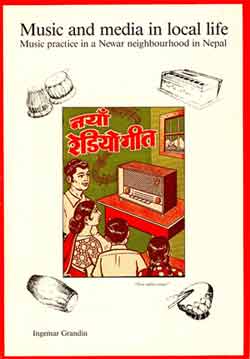 • Grandin, Ingemar (1989). Music and media in local life: Music practice in a Newar neighbourhood in Nepal. Linköping studies in arts and science, 41. Linköping, Sweden: Linköping University.
• Grandin, Ingemar (1989). Music and media in local life: Music practice in a Newar neighbourhood in Nepal. Linköping studies in arts and science, 41. Linköping, Sweden: Linköping University.
• Grönvall, Jenny (2008). Access to water Rights, obligations and the Bangalore situation. Linköping: Tema Institute, Linköping University.
• Guieysse, Benoit (2001). Innovative bioreactors for the degradation of polycyclic aromatic hydrocarbons. Lund: Dept. of Biotechnology (Avd. för bioteknik), Univ.
• Gupta, Ram (2002). A shift in Dharma – changes in conceptualisations of faith among second-generation Hindus in Oslo. Oslo: Linguistics and Scandinavian studies – university of Oslo.
H
• Hadders, Hans (2001). The gift of the eye: mortuary ritual performed by the Jadopatias in the Santal villages of Bengal and Bihar, India. Trondheim Occasional Papers in Social Anthropology, 8. Trondheim: Norwegian University of Science and Technology, Department of Social Anthropology.
• Hammar, Urban (2005). Studies in the Kalacakra Tantra: a history of the Kalacakra in Tibet and a study of the concept of Adibuddha, the fourth body of the Buddha and the supreme unchanging. Stockholm: Department of Ethnology, History of Religions.
• Hansen, Kristin (2002). Thoughts, Feelings and the Significance of Social Ties as Invoked by a Family of Vaishnava Mendicant Renouncers in Bengal. University of Oslo.
• Hansson, Sidsel (2001). Not just any water: hinduism, ecology, and the Ganges water controversy. Lund studies in African and Asian religions, 13.
• Hardtmann, Eva-Maria (2003). "Our fury is burning": local practice and global connections in the Dalit movement. Stockholm studies in social anthropology, 54. Stockholm: Dept. of Social Anthropology [Socialantropologiska institutionen], Univ.
• Heegård Petersen, Jan (2006). Local case-marking in Kalasha. Dept. of Nordic Studies and Linguistics, University of Copenhagen.
• Heierstad, Geir (2009). Images of Kumartuli Kumars – The Image-Makers of Kolkata. Acta Humaniora No. 382, Faculty of Humanities, University of Oslo. ![]()
• Hemmilä, Olavi (2002). En yogi kommer till stan: Indisk religiositet i svensk skönlitteratur med särskild tonvikt på Dan Anderssons författarskap. Acta Universitatis Stockholmiensis, 46. Stockholm, Sweden: Almqvist & Wiksell International.
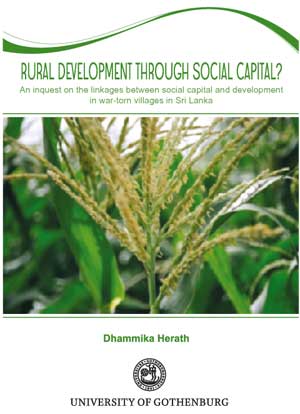 • Herath, Dhammika (2008). Rural development through social capital?: an inquest into the linkages between social capital and development in war-torn villages in Sri Lanka. Göteborg: Peace and Development Research, School of Global Studies, University of Gothenburg.
• Herath, Dhammika (2008). Rural development through social capital?: an inquest into the linkages between social capital and development in war-torn villages in Sri Lanka. Göteborg: Peace and Development Research, School of Global Studies, University of Gothenburg.
• Hettne, Björn (1978). The Political Economy of Indirect Rule. Mysore 1881 – 1947. Scandinavian Institute of Asian Studies Monograph Series/Curzon Press.
• Hindman Persson, Therese (2002). Economic analyses of drinking water and sanitation in developing countries. Lund economic studies, 101.
• Hole, Elisabeth Åsa (2005). Neither here - nor there: an anthropological study of Gujarati Hindu women in the diaspora. Dissertations and documents in cultural anthropology, 5. Uppsala: Institutionen för kulturantropologi och etnologi, Uppsala universitet [distributör].
• Hossain, Mohammed (2002). Regional conflict transformation: a reinterpretation of South Asian Association for Regional Co-operation (SAARC). Interkont books, 11. [Helsinki]: Institute of Development Studies, University of Helsinki.
• Härnström, Karolina (2009). Bloom Dynamics and Population Genetics of Marine Phytoplankton. Community, Species and Population Aspects. University of Gothenburg/Faculty of Science/Department of Marine Ecology. ![]()
• Höglund, Kristine (2004). Violence in the midst of peace negotiations: cases from Guatemala, Northern Ireland, South Africa and Sri Lanka. Report / Department of peace and conflict research, Uppsala University, Sweden, 69. Uppsala: Department of Peace and Conflict Research, Uppsala University.
I
• Inkinen, Magdalena (2003). Mobilising the lower castes: the rise of the Bahujan Samaj Party in India. Uppsala: Statsvetenskapliga institutionen, Univ.
J
• Jakariya, Mohammed (2007). Arsenic in tubewell water of Bangladesh and approaches for sustainable mitigation. Trita-LWR., 1033. Stockholm: Byggvetenskap, Kungliga Tekniska högskolan.
• Jansson, Erland (1981). India, Pakistan or Pakhtunistan? (Acta Universitatis Upsaliensis. Studia historica Upsaliensia, 119).
• Jensen, Ole (2007). Beyond mountains: The impact of Pakistani territorialisation on Balti livelihoods and migration practices. Graduate School of International Development Studies, Roskilde University (RUC), Denmark.
 • Johansson, Erik (2006). Urban design and outdoor thermal comfort in warm climates: studies in Fez and Colombo. Lund: Lund University.
• Johansson, Erik (2006). Urban design and outdoor thermal comfort in warm climates: studies in Fez and Colombo. Lund: Lund University.
• Jonasson, Ann-Kristin (2004). At the Command of God?: on the political linkage of Islamist parties. Göteborg studies in politics, 89. Göteborg, Sweden: Centre for Middle Eastern Studies, Göteborg University.
• Juntunen, Mirja (2004). The town plan of Jaipur: its sources and narrations. Stockholm: Dept. of Indology [Institutionen för orientaliska språk, Avd. för indologi].
• Jørgensen, Helle (2010). Tranquebar – Whose History? Transnational Cultural
Heritage in a Former Danish Trading
Colony in South India. Institute of
History and Area Studies, Aarhus University, Denmark. ![]()
K
• Kabir, Zarina Nahar (2001). The emerging elderly population in Bangladesh: aspects of their health and social situation. Stockholm, Sweden: Dept. of Clinical Neuroscience, Occupational Therapy and Elderly Care Research (NEUROTEC), Division of Geriatric Medicine, Karolinska Institutet.
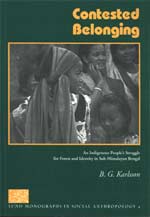 • Karlsson, Bengt G. (1997). Contested Belonging: An Indigenous People's Struggle for Forest and Identity in Sub-Himalayan Bengal. Uppsala University.
• Karlsson, Bengt G. (1997). Contested Belonging: An Indigenous People's Struggle for Forest and Identity in Sub-Himalayan Bengal. Uppsala University.
• Karlsson, Pia, & Mansory, Amin (2007). An Afghan dilemma: education, gender and globalisation in an Islamic context. Stockholm: Institute of International Education, Department of Education, Stockholm University.
• Kaur, Ravinder (2004). Narratives of resettlement: past, present and politics among 1947 Punjabi State and its role in partition. Roskilde: Roskilde University Centre (RUC).
• Ketola, Kimmo (2002). An Indian guru and his western disciples: representation and communication of charisma in the Hare Krishna movement. Helsinki: [K. Ketola].
• Kjosavik, Darley Jose (2005). In the intersection of class and indigeneity: the political economy of indigenous people's development in Kerala. Norwegian University of Life Sciences (UMB).
• Kristvik, Ellen (2002). Nepali Sex Workers: Narratives of Violence and Agency. Oslo: University of Oslo.
• Kumar, Rupesh (2006). Ergonomic evaluation and design of tools in cleaning occupation. Doctoral thesis / Luleå University of Technology, 2006:16. Luleå: Luleå tekniska universitet/Arbetsvetenskap/Product Design. http://epubl.ltu.se/1402-1544/2006/16/.
• Kumari, W.M.S.M. (2008). A Study of War-Affected Children in Sri Lanka. Licentiate thesis. School of Global Studies,
Göteborg University. ![]()
L
• Laine, Anna (2009). In Conversation with the Kolam Practice. Auspiciousness and Artistic Experiences among Women in Tamilnadu, South India. School of Global Studies,
Göteborg University ![]()
• Landström, Ingegerd (2006). Towards collaborative coastal management in Sri Lanka?: a study of special area management planning in Sri Lanka's coastal region. Geografiska regionstudier, 70. Uppsala: Department of Social and Economic Geography, Uppsala University [Kulturgeografiska institutionen, Uppsala universitet].
• Lannerstad, Mats (2009). Water Realities and Development Trajectories – Global and Local Agricultural Production Dynamics. Faculty of Arts and Sciences, Linköping
University, No. 475. ![]()
• Larsen, Mattias (2009). Vulnerable Daughters in Times of Change: Emerging Contexts of Discrimination in Himachal Pradesh, India. School of Global Studies,
Göteborg University ![]()
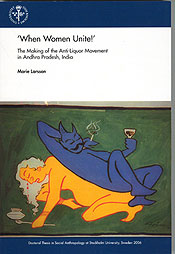 • Larsson, Marie (2006). "When women unite!": the making of the Anti-Liquor Movement in Andhra Pradesh, India. Stockholm studies in social anthropology, 60. Stockholm: Department of Social Anthropology, Stockholm University.
• Larsson, Marie (2006). "When women unite!": the making of the Anti-Liquor Movement in Andhra Pradesh, India. Stockholm studies in social anthropology, 60. Stockholm: Department of Social Anthropology, Stockholm University.
• Lejonhud, Kristina (2003). Indian villages in transformation: a longitudinal study of three villages in Uttar Pradesh. Karlstad University studies, 2003:11. Karlstad: Karlstad University.
• Liljegren, Henrik (2008). Towards a grammatical description of Palula, an Indo-Aryan language of the Hindu Kush. Stockholm: Stockholm University.
• Lindberg, Anna (2001). Experience and Identity: A Historical Account of Class, Caste and Gender among the Cashew Workers of Kerala, 1930–2000. Lund University.
• Lindberg, Jonas (2005). Education for all in times of global transformations: aspirations and opportunities of poor families in marginal areas of Sri Lanka. Göteborg: Kulturgeografiska Institutionen, Handelshögskolan vid, Göteborgs Universitet.
M
• Mahmud, Minhaj (2005). Measuring trust and the value of statistical lives: evidence from Bangladesh. Thesis (doctoral), Göteborg University, 2005.
• Mageli, Eldrid (2001). NGO Activism in Calcutta 1973–1997. Exploring Unnayan. University of Oslo.
• Malla, Katak B. (2005). The legal regime of international watercourses: progress and paradigms regarding uses and environmental protection. Stockholm: Department of Law, Stockholm University.
• Mathai, Elizabeth (2004). Genital and urinary tract infections in pregnancy in southern India: diagnosis, management and impact on perinatal outcome.
• Mehdi, Rubya (2001). Gender and property law in Pakistan: resources and discourses. Copenhagen: DJØF Pub.
• Miaji, Abdel Baten (2010). Rural Women in Bangladesh: The Legal Status of Women and the Relationship between NGOs and Religious Groups. Section of Islamology, Department of History of Religions; Centre for Theology and Religious
Studies, Lund University. Lund Studies in History of Religions, Volume 26. ![]()
• Myrvold, Kristina (2007). Inside the Guru’s Gate. The Ritual Uses of Texts among the Sikhs in Varanasi. Lund: Division of Indic Religions, Department of History and Anthropology of Religion, Lund University.
• Möller, Ulrika (2007). The prospects of security cooperation: a matter of relative gains or recognition? : India and nuclear weapons control. Göteborg studies in politics, 105. Göteborg: Department of Political Science, Göteborg University.
N
• Najimi, Abdul Wasay (1988). Herat, the Islamic city: a study in urban conservation. Curzon Press/Scandinavian Institute of Asian Studies. School of Architecture, Royal Danish Academy of Arts, Copenhagen.
• Nilsen, Alf Gunvald (2006). The valley and the nation – the river and the rage. A study of dispossession and resistance in the Narmada valley. Bergen: Dept. Of Sociology, University of Bergen.
• Nilsson, Jan (2005). Understanding health-related quality of life in old age: a cross-sectional study of elderly people in rural Bangladesh. Stockholm: Division of Geriatric Epidemiology, Department of Neurotec, Karolinska institutet.
• Nordin, Andreas (2006). Ge ifrån och föra hem: kognitiva aspekter av pilgrimsfärder i Himalaya. Göteborgs Universitet, School of Global Studies.
• Norström, Christer (2003). "They call for us": strategies for securing autonomy among the Paliyans, hunter-gatherers of the Palni Hills, South India. Stockholm studies in social anthropology, 53. Stockholm: Dept. of Social Anthropology, Stockholm University.
• Nyberg, Catarina (2006). Flerkulturella identifikationer i ett svensk-uganda-indiskt sammanhang. Doktorsavhandlingar från Pedagogiska institutionen, Stockholms universitet, 136. Stockholm: Pedagogiska institutionen, Stockholms universitet.
• Nyborg, Ingrid (2002). Yours Today, Mine Tomorrow? A Study of Women and Men’s Negotiations over Resources in Baltistan, Pakistan. Agricultural University of Norway.
O
• Offermanns, Jürgen (2002). Der lange Weg des Zen-Buddhismus nach Deutschland: vom 16. Jahrhundert bis Rudolf Otto. Lund: Religionshistoriska avdelningen, Lunds universitet.
• Olsson, Torvald (1988). Folkökning, Fattigdom, Religion. Objektivitetsproblem i högstadiets läromedel 1960–1985 med särskild inriktning på Indien- och U-landsbilden. Lunds Universitet. Plus Ultra Bokförlag, Löberöd. ![]()
• Orjuela, Camilla (2004). Civil society in civil war: peace work and identity politics in Sri Lanka. Göteborg: Department of Peace and Development Research, Göteborg University.
• Ostwald, Madelene (2000). Local protection of tropical dry natural forest, Orissa, India. Earth Sciences Centre, Göteborg University, 51. Göteborg: Institutionen för geovetenskaper, Univ.
P
• Palm, Matilda (2009). Land Use in Climate Policy. Forest Based Options at Local Level with Cases from India. Faculty of Science, University of Gothenburg ![]()
• Pathmasiri, Wimal (2007). Structural and Biophysical Studies of Nucleic Acids. Digital Comprehensive Summaries of Uppsala Dissertations from the Faculty of Science and Technology, 349. Uppsala: Acta Universitatis Upsaliensis.
• Persson, Viveca (2001). Vitamin A intake, status and improvement using the dietary approach: studies of vulnerable groups in three Asian countries. Uppsala: Acta Universitatis Upsaliensis.
• Petersson, Margareta (1988). Indien i svenska reseskildringar 1950-75. Litteratur, teater, film, nya serien, 3. Lund: Lund University Press.
• Piltz, Åsa (2005). Seger ät Tibet!: den tibetanska diasporan och den religiösa nationen. Lund studies in African and Asian religions, 16. Lund: Department of History and Anthropology of Religions, Lund University.
• Premathilake, Rathnasiri (2003). Late Quaternary palaeoecological event stratigraphy in the Horton Plains, central Sri Lanka: with contributions to the recent pollen flora. Avhandling i kvartärgeologi. Stockholm University.
R
 • Rahman, Mahfuzar (1999). Nonmalignant health effects of arsenic exposure. Linköping University medical dissertations, 612. Linköping University.
• Rahman, Mahfuzar (1999). Nonmalignant health effects of arsenic exposure. Linköping University medical dissertations, 612. Linköping University.
• Ranta-Tyrkkö, Satu (2010). At the Intersection of Theatre and Social Work in Orissa, India: Natya Chetana and Its Theatre. Department of Social Work Research, University of Tampere, Finland. ![]()
• Rogersdotter, Elke (2006). The forgotten: an approach on Harappan toy artefacts. Archaeology and environment, 20. University of Umeå, Dept. of Archaeology and Sami Studies.
S
• Sardella, Ferdinando (2010). Bhaktisiddhanta Sarasvati. The Context and Significance of a Modern Hindu Personalist. Department of Literature, History of Ideas, and Religion, University of Gothenburg. ![]()
• Schweizer, Roger (2005). An arranged marriage under institutional duality: the local integration process between two globally merging MNCs' subsidiaries. Göteborg: BAS Publishing, School of Business, Economics and Law, Göteborg University.
• Selliah, Amirthalingam (2003). Murukak Katavul Valipa in study of the worship of god Murukan in Malaiyakam on Ilam and in Tamilakam. Uppsala: Dept. of Theology, History of Religions.
• Singh, Simron Jit (2003). In the sea of influence: a world system perspective of the Nicobar Islands. Lund studies in human ecology, 6.
• Singh Parihar, Vishal (2008). Human listeriosis: Sources and Routes”. Örebro Studies in Medicine 19. Dept. of Restaurant and Culinary Arts, Academy of Health Science, Örebro University, Campus Grythyttan.
• Sissener, Tone (2008). A State of Corruption? An Anthropology of the South Asian State. Bergen: University of Bergen.
• Sjödin, Anna-Pya (2006). The happening of tradition: Vallabha on Anumana in Nyayali la vati. South Asian Studies (Uppsala), 1. Uppsala: Acta Universitatis Upsaliensis.
• Somadeva, Raj (2006). Urban origins in southern Sri Lanka. Studies in global archaeology, 7. Uppsala: Department of Archaeology and Ancient History, African and Comparative Archaeology, Uppsala University.
• Strøm, Axel Kristian (2001). Continuity, Adaptation and Innovation: Tibetan Monastic Colleges in India. University of Oslo.
• Ståhlberg, Per (2002). Lucknow daily: how a Hindi newspaper constructs society. Stockholm studies in social anthropology, 51. Stockholm: Stockholm Studies in Social Anthropology.
• Ståhle, Göran Viktor (2004). Det religiösa självet i praktik vid ett hinduiskt gudinnetempel: ett kulturpsykologiskt angreppssätt för religionspsykologi. Uppsala: Uppsala universitet.
T
• Tavares, Rodrigo (2006). Understanding regional peace and security: a framework for analysis. Göteborg. Department of Peace and Development Research, School of Global Studies, Göteborg University.
• Thynell, Marie (2003). The unmanageable modernity: an explorative study of motorized mobility in development. Göteborg: Dept. of Peace and Development Research, Univ.
• Tiljander Dahlström, Åsa (2001). No peace of mind: the Tibetan diaspora in India. Uppsala: Univ.
• Toft Madsen, Stig (1996). State, society and human rights in South Asia. New Delhi: Manohar.
• Tropp, Håkan (1998). Patronage, politics and pollution: precarious NGO-state relationships : urban environmental issues in south India. Linköping studies in arts and science, 182. Linköping: Tema, Univ.
U
• Uba, Katrin (2007). Do protests make a difference?: the impact of anti-privatisation mobilisation in India and Peru. Uppsala: Uppsala universitet.
V W
• Vinthagen, Stellan (2005). Ickevåldsaktion: en social praktik av motstånd och konstruktion. Göteborg: Institutionen för freds- och utvecklingsforskning (PADRIGU), Göteborgs universitet.
• Waldrop, Anne (2002). A Room with One´s Own. Educated Elite People in New Delhi and Relations of Class. University of Oslo.
• Walldén, Ruth (1982). Studies in Dravidian Phonology and Vocabulary. Uppsala: Acta Universitatis Upsaliensis.
• Wendt, Rasmus (2008). TRIPs in India – An analysis of the impact of global governance on political processes in India and the wider institutional settings for the pharmaceutical industry. Roskilde University (RUC), Denmark.
• Widlund, Ingrid (2000). Paths to power and patterns of influence: the Dravidian parties in South Indian politics. Skrifter utgivna av Statsvetenskapliga föreningen i Uppsala, 140. Uppsala: Acta Universitatis Upsaliensis.
• Widmalm, Sten (1997). Democracy and violent separatism in India: Kashmir in a comparative perspective. Routledge/Curzon 2002.
• Wilhite, Hal (2006). Why is consumption changing in Kerala? An ethnographic approach. Oslo: Centre for development and the environment (SUM), University of Oslo.
• Wilk, Julie (2000). Do forests have an impact on water availability?: assessing the effects of heterogeneous land use on streamflow in two monsoonal river basins. Linköping studies in arts and science, 222. Linköping: Tema, Univ.
• Winsvold, Aina (2004). När arbeidende barn mobiliserer seg: en studie av tre unioner i Karnataka, India. Lund dissertations in sociology, 62. Lund: Sociologiska institutionen, Univ.
• Witharana, Sanjeeva (2003). Boiling of refrigerants on enhanced surfaces and boiling of nanofluids”. Licentiate thesis from Division of Applied Thermodynamics and Refrigeration, Department of Energy Technology, Kungliga Tekniska Högskolan (KTH), Stockholm
More information about the South Asia related theses defended at Nordic universities since 1997,
see http://www.sasnet.lu.se/dissert.html
SASNET - Swedish South Asian Studies Network/Lund
University
Address: Scheelevägen 15 D, SE-223 70 Lund, Sweden
Phone: +46 46 222 73 40
Webmaster: Lars Eklund
Last updated
2010-06-24
